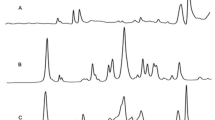Summary
The polar electron-deficient alkene methyl acrylate was readily polymerised in good yield by the CpTiCl3-MAO system to give a polymer with a relatively low molecular weight, but reasonable polydispersity. The polymer appears to be atactic. The same system also gave a random sequence 1:1 copolymer of methyl acrylate and styrene, which according to NMR and SEM studies was a true copolymer rather than a blend.
Similar content being viewed by others
References
Zambelli A, OlivaL, Pellecchia C (1989) Macromolecules 22:2129
Ricci G, Bosisio C, Porri L (1996) Makromol Rapid Commun 17:781
Longo P, Grassi A, Grisi F, Milione S (1998) Macromol Rapid Commun 19:229
Meille SV, Capelli S, Ricci G (1995) Macromol Rapid Commun 16:891
Tomotsu N, Ishihara N, Newman TH, Malanga MT (1998) J Mol Cat A: Chem 128:167
Pellecchia C, Proto A, Zambelli A (1992) Macromolecules 25:4450
Endo K, Senoo K (1998) Makromol Rapid Commun 19:563
(a) Liu S, Huang B (1999) Makromol Rapid Commun 20:484; (b) Kim KH, Jo WH, Kwak S, Kim KU, Kim J (1999) Makromol Rapid Commun 20:175; (c) Nomura K, Okumura H, Komatsu T, Naga N, Imanishi Y (2002) J Mol Cat A: Chemical 190:225
(a) Li YF, Ward DG, Reddy SS, Collins S (1997) Macromolecules 30:1875; (b) Collins S, Ward DG, Suddaby KH (1994) Macromolecules 27:7222; (c) Yasuda H, Yamamoto H, Yamashita M, Yokota K, Nakamura A, Miyaki S, Kai Y, Nanehisha N (1993) Macromolecules 26:7134; (d) Yasuda H, Yamamoto H, Yokota K, Miyaki S, Nakamura A (1992) J Am Chem Soc 114:4908
Boffa LS, Novak BM (2000) Chem Rev 100:1479
Toshinori T, Masahiko K, PCT Int Appl WO 90 12,039 (Cl C08F12/08); (1991) Chem Abs 114: 82805a.
Jensen TR, Yoon SC, Dash AK, Luo L, Marks TJ (2003) J Am Chem Soc 125:14482
Qian M, Bala D, Yousaf M, Zhang H, Huang J, Sun J, Liang C (2002) J Mol Cat A: Chemical 188:1 notes a cationic polymerisation of methyl methacrylate by an allylcyclopentadienyl lanthanide, but no MAO was needed. In the CpTiCl3-MAO system described by us here, no polymerisation was observed in the absence of MAO. There was some polymerisation with MAO in the absence of CpTiCl3, but the 1 h yield was < 4% compared with the 1 h yield of >15% when CpTiCl3 was present.
Pouchet CJ (1981) The Aldrich Library of Infrared Spectra 3rd edition. Aldrich. Milwaukee
(a) Kang KK, Oh JK, Jeong YT, Shiono T, Ikeda T (1999) Makromol Rapid Commun 20:308; (b) Kim KH, Jo WH, Kwak S, Kim KU, Kim J, (1999) Macromol Rapid Commun 20:175
Blends of polystyrene-polyisoprene (Zhao H, Huang B, !1998) J Poly Sci Polym Phys 36:85) and polybutadiene-poly(methyl acrylate) (Chattopadhyay S, Sivaram S (2001) Polym Int 50:67) show distinct phases at the 1 – 5 -μm level
Author information
Authors and Affiliations
Corresponding author
Rights and permissions
About this article
Cite this article
Cunningham, I., Fassihi, K. The cyclopentadienyltitanium trichloride/MAO-catalysed polymerisation of methyl acrylate and copolymerisation with styrene and isoprene. Polym. Bull. 53, 359–365 (2005). https://doi.org/10.1007/s00289-005-0343-z
Received:
Revised:
Accepted:
Published:
Issue Date:
DOI: https://doi.org/10.1007/s00289-005-0343-z



